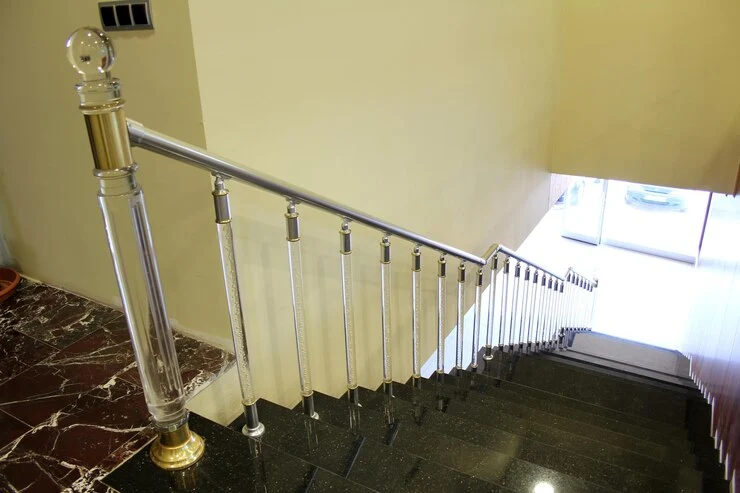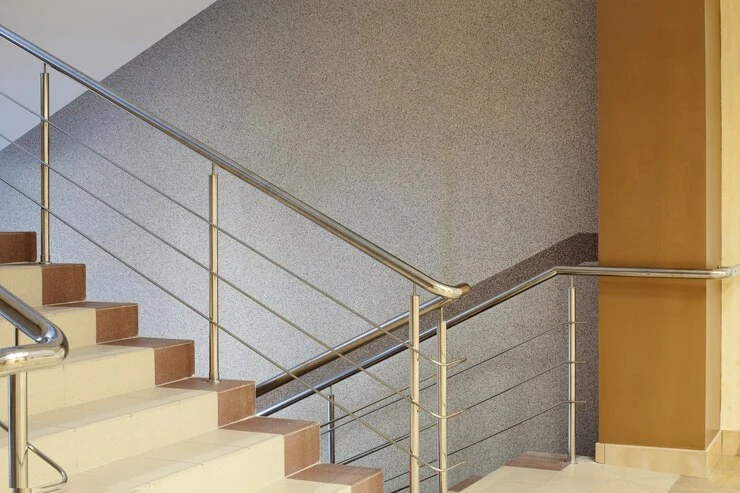An interior handrail is an important feature in any home or building. It provides support when using stairs, ramps, or other elevated areas. But handrails are more than just for safety, they can also make your space look beautiful and complete.
Here, we’ll explain everything you need to know about interior handrails, including the materials, designs, and how to maintain them.
What Is an Interior Handrail?
An interior handrail is a railing placed along stairs or walls to help people hold on and stay balanced. They are especially helpful for children, elderly individuals, and anyone who might need extra support.
Handrails also add structure to your home and are required by most building laws to ensure safety. Beyond their function, they can also enhance the style of your space.
Key Benefits of Interior Handrails
Interior handrails serve a dual purpose of functionality and aesthetics. Here are some main advantages:
- Safety and Support: Prevent accidents by offering a sturdy grip.
- Accessibility: Aid mobility for people with physical challenges.
- Aesthetic Appeal: Add character and elegance to interiors.
- Increased Property Value: High-quality handrails can enhance the resale value of your home.
Popular Materials for Interior Handrails
Choosing the right material for your interior handrail is crucial. Here are some popular options:
Wood
- Advantages: Warm, natural look; customizable; blends well with traditional and modern interiors.
- Disadvantages: Requires regular maintenance; prone to scratches and dents.
Metal
- Advantages: Durable, sleek, and versatile; ideal for modern or industrial styles.
- Disadvantages: Can be expensive; may feel cold to the touch.
Glass
- Advantages: Contemporary and stylish; creates a sense of openness.
- Disadvantages: Expensive; requires frequent cleaning to maintain transparency.
Acrylic
- Advantages: Lightweight, affordable, and easy to maintain.
- Disadvantages: Less durable than wood or metal.
Wrought Iron
- Advantages: Adds a classic and luxurious touch; highly durable.
- Disadvantages: Requires professional installation and maintenance.
Styles of Interior Handrails
Interior handrails come in various styles to suit different tastes and requirements. Some popular styles include:
Wall-Mounted Handrails
Ideal for compact spaces, these handrails are directly attached to walls.
Freestanding Handrails
Perfect for wide staircases, these are supported by posts and don’t require wall mounting.
Minimalist Designs
Characterized by sleek and simple lines, minimalist handrails work well in contemporary interiors.
Ornate and Decorative Designs
Featuring intricate details, these handrails add a touch of luxury and are great for traditional spaces.

How to Choose the Right Interior Handrail?
Selecting the perfect handrail requires consideration of several factors:
- Functionality: Does it meet safety and accessibility requirements?
- Material and Finish: Ensure it complements the overall decor.
- Building Codes: Confirm compliance with local regulations.
- Budget: Choose a material and design within your financial limits.
Installation Tips for Interior Handrails
Proper installation is critical to ensure safety and functionality. Here are some tips:
- Measure Precisely: Take accurate measurements of the staircase or ramp.
- Follow Building Codes: Ensure the height and spacing meet legal requirements.
- Secure Fastening: Use strong brackets and screws to attach the handrail securely.
- Hire Professionals: While DIY installation is possible, hiring a professional ensures a safer and more polished outcome.
Maintenance of Interior Handrails
To keep your handrails looking great and functioning effectively:
- Regular Cleaning: Use appropriate cleaning products for the material.
- Inspect for Damage: Check for loose brackets, cracks, or rust.
- Refinishing: Periodically refinish wooden handrails to maintain their appeal.
- Lubrication: For metal handrails, apply lubricant to prevent squeaking.
Interior Handrails for Accessibility
If you’re designing a space for accessibility, handrails play a vital role:
- ADA Compliance: Handrails in public spaces must meet the Americans with Disabilities Act (ADA) standards.
- Ergonomic Design: Choose a design that’s easy to grip and follow along with smooth transitions.
- Dual Rails: For wider staircases, consider installing dual handrails for added support.
Creative Uses of Interior Handrails
Handrails aren’t limited to staircases. Here are some creative uses:
- Room Dividers: Use decorative handrails as room separators.
- Artistic Features: Incorporate intricate designs for a statement piece.
- Shelving Support: Repurpose handrails as supports for floating shelves.
How Much Do Handrails Cost?
The price of an interior handrail varies based on the material, design, and how complex the installation is:
- Basic Wooden Handrails: $20–$50 per linear foot.
- Metal Handrails: $50–$150 per linear foot.
- Glass Handrails: $150–$250 per linear foot.
Labor costs vary depending on the region and project scale, with professional installation typically ranging from $200 to $1,000.
FAQs
What is interior railing?
Interior railing refers to the protective barrier or support system installed inside buildings, typically along staircases, balconies, or elevated walkways. It ensures safety and can improve the look of the space.
What are indoor stair railings called?
Indoor stair railings are commonly called handrails or banisters. They provide support for users while ascending or descending stairs and are often attached to walls or supported by posts.
How is a handrail different from a wall rail?
- A handrail is a general term for any rail you hold for support, often attached to posts or walls.
- A wall rail is a handrail attached directly to a wall..
What is the best shape for a handrail?
The best shape for a handrail is one that is rounded or oval. These shapes are easier to grip, comfortable for the hand, and reduce the risk of accidents.
Conclusion
Interior handrails are essential for safety and add a touch of style to any space. Whether you choose wood, metal, or glass, picking the right handrail can transform your home. Remember to install it securely, clean it regularly, and ensure it matches your decor.
By taking the time to choose the right design and material, you’ll have a handrail that not only keeps your family safe but also enhances the beauty of your home.




